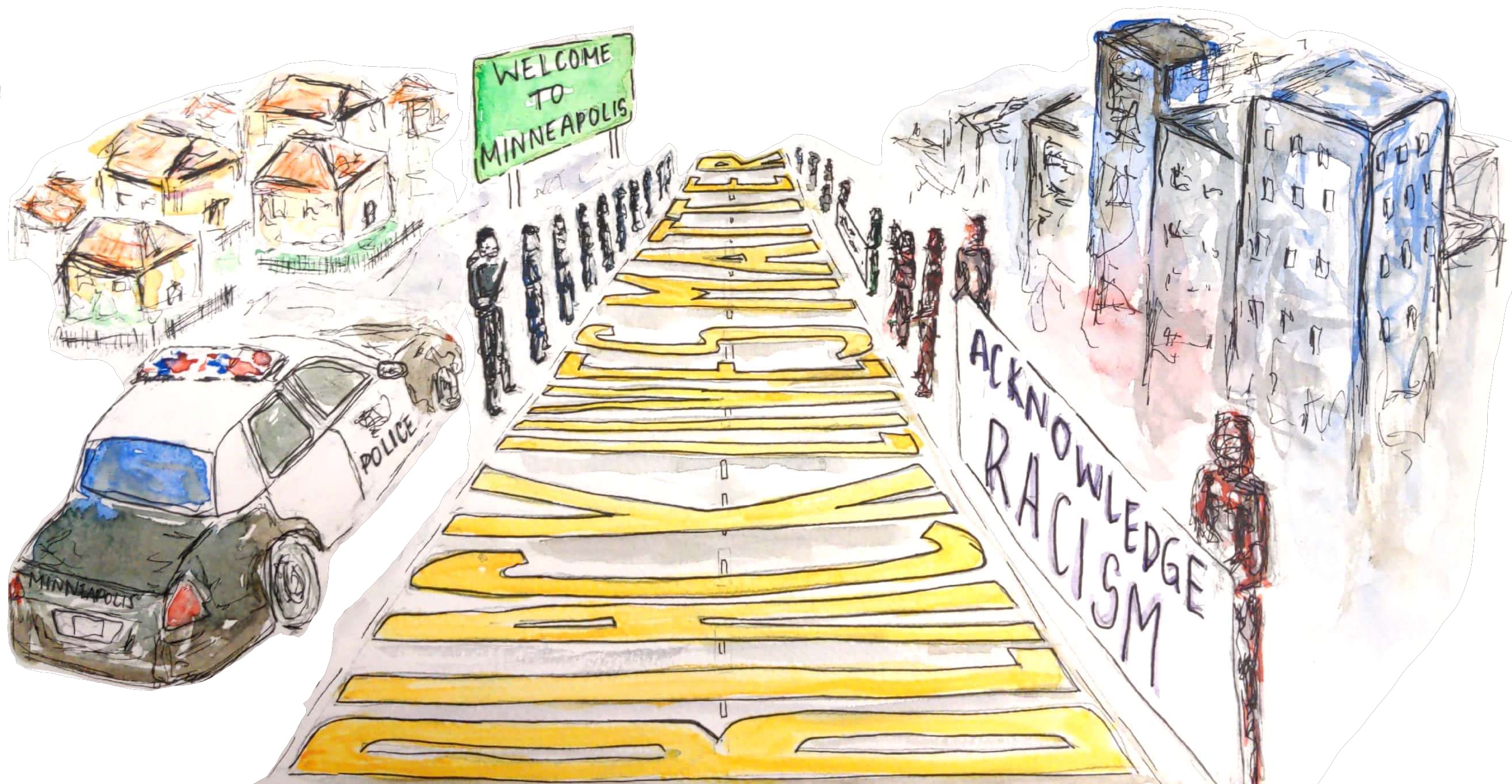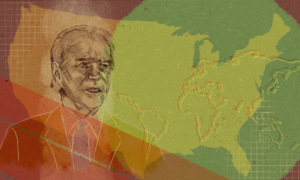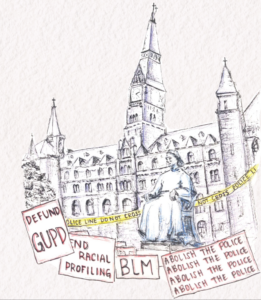Content warning: This article includes heavy mention of racism, racist violence, and police brutality.
Tucked in the outskirts of Minneapolis, Namaste Cafe has been my friend group’s favorite restaurant since high school. After we all left for college, the intimate “Nam” transformed from our regular study space to the site of our reunions. But when I returned home this past December, my friend group opted for takeout instead. It wasn’t because we were suddenly too lazy to make the twenty-minute commute or afraid to brave the Minnesota cold. Rather, the steady increase in violent crime and carjackings in central Minneapolis had spread out from the city center to a point where we didn’t feel comfortable eating dinner on Hennepin Avenue anymore.
Nakedly, the statistics show crime in Minneapolis has reached its highest point in twenty years. Murders in Minneapolis increased by 57 percent in 2020, arson rose by 53 percent, and auto theft increased by 20 percent. In 2021, the state reported 96 homicides and 2182 robberies, 619 of which were carjackings. In researching what caused the crime surge, I repeatedly encountered a narrative permeated throughout local media, casual conversations, and academic discourse attributing the crime increase to the racial justice protests that reignited in response to George Floyd’s murder by police in May 2020.
This narrative is neither accurate nor comprehensive given that it ignores the effects of the pandemic’s economic consequences, school closures, and gun sales on crime rates. Yet without clearer messaging, context, and perspective, we become susceptible to false and racist narratives produced by media outlets, politicians, and even our own neighbors.
In 2021, a number of media outlets cited University of Utah Law professor Paul Cassell’s study, “The Minneapolis Effect,” which links the increase in violent crime to the reduction of proactive policing due to the redeployment of officers to protest sites. Naming a nationwide rise in crime after the city George Floyd was murdered in casts Black Lives Matter as a movement that culminated in more violence, rather than one that exposed the systemic racism and criminal justice inequities that exist in our country.
This assertion makes it far too easy to forget, to undervalue, and to entirely disregard the horrifyingly painful nine minute and 29 second video of George Floyd’s murder by Derek Chauvin and the 15 to 26 million people who participated in demonstrations in over 2,000 locations over the summer of 2020 in response.
This uncritical attribution of the nationwide increase in crime to the protests of that summer, without regard for other potential contributing factors, is a disservice to the Black Lives Matter movement and racial justice efforts more generally.
It would be remiss of me to not acknowledge that the timing does line up with homicides, assaults, and gun violence increasing in summer 2020, right when nationwide protests began. But causative claims tying the demands of Black Lives Matter to the increase of crime fail in the face of reality: Police were not defunded in Minneapolis, and cities that increased their police budgets, such as Tucson and Toledo, also saw a rise in homicide rates.
The uncanny parallels between the ways we associate violence and race in 2020 (despite 93 percent of 2020 protests being peaceful, 42 percent of respondents polled believed they were unequivocally violent) and the way violence is being discussed in 2022 has forced me to consider what change has actually occurred since the nationwide protests now two full years ago. In the wake of the recent murder of Amir Locke by the Minneapolis Police Department and the repeated failure of the federal government to pass the George Floyd Justice in Policing Act of 2021, it is evident that the nationwide calls to action have, again, fallen on deaf ears.
While I cannot claim to have the solution to prevent these racist associations from permeating national psyche, I believe that anti-racist teaching and individual accountability are needed to strengthen our proclivity to question the information that is presented to us and the facts that are omitted.
In 2020, after learning of the murder of George Floyd, I was horrified that such a callous crime could be committed in a state I spent my childhood believing was the best place to grow up. I went to high school ten minutes away from where George Floyd was murdered. Yet not once in my entire academic career did we acknowledge the extreme segregation that exists in Minnesota. My private high school was predominantly white, predominantly upper-middle and upper class, and most everybody lived west of Hennepin Avenue (yes, home to Namaste Cafe).
I had never given much thought to this somewhat invisible geographic barrier before I went to college, and even then, attending a predominantly white university didn’t seem all that surprising to me when I was one of 32 people of color in a high school class of 134, with only six students being Black. It wasn’t until a friend explained how Georgetown was a culture shock because of the homogeneity on campus that I really started reflecting on the diversity—more accurately, the lack thereof—of my upbringing.
Before 2020, the Minneapolis I grew up in, and the one most residents would have attested to, pretty much went unnoticed in the national conversation: It’s cold and there are a lot of lakes. We pride ourselves on being friendly and welcoming. Minneapolis turns blue every time an election rolls around; thousands of immigrants from Mexico, Somalia, India, and Laos have moved to the state in the past thirty years. Places like Eat Street in Minneapolis highlight diverse cuisines from around the world, and the Minnesota Keystone Program coordinates huge amounts of philanthropic work year-round. But this glossy picture of multicultural liberalism has acted as a veneer, hiding the truth of our racist history.
Minnesota’s legacy of racial segregation can be traced back to racial covenants in 1910 that barred people of color from owning property in certain neighborhoods. This practice, coupled with redlining—the government’s assignment of minority-occupied neighborhoods with a lower property value—effectively isolated Black communities from the level of infrastructural and educational investment experienced by their white counterparts and entrenched racial segregation in Minnesota. Over a century later, only 23 percent of Black residents are homeowners compared to 75 percent of white residents, contributing to some of the worst achievement and wealth gaps in the nation. This segregation means many white residents do not even recognize their own privileges and advantages because they are physically shielded from seeing the inequities that do exist.
Being a person of color living in a western outskirt of Minneapolis put me in the unique position of both benefiting from and being on the receiving end of the blatant privilege and bias that dominates the suburbs. The racism here often isn’t direct; there are no vicious confrontations. Instead, the microaggressions are subtle and the segregation is so deep-rooted that people don’t notice it—or don’t talk about it. A carpool mom asking me where I’m really from despite living in one city my entire life. The same photo of me appearing four times in one school brochure. Being the only one of my friends with brown eyes.
The irony of Minneapolis and its neighboring cities is that no one intentionally targets others—the stereotype of “Minnesota nice” is a fairly accurate one—but the supposed homogeneity of the western suburbs allows individuals to get away with harmful misinformation and subtle microaggressions that only perpetuate our ignorance as a population. Since no one takes—or took—the time to acknowledge inherent biases and surroundings, or educate students about the disparities of Minneapolis and the structural causes behind them, few realize that these events are problematic or even prevalent.
When the suburbs surrounding Minneapolis went into curfew because of the “violent riots” that followed George Floyd’s murder, I spent the night at a friend’s house twenty-five minutes outside of the city. From the news coverage we got in her house on Lake Minnetonka, we would have never known that there were massive peaceful protests happening throughout the county. The nightly programs showed only seconds of peaceful marches between minutes of violence, leading the general population to believe that our city, the one we prided as being liberal and welcoming and tolerant, was being burned to the ground by violent “radicals.” There was no mention of the thousands of dollars or thousands of volunteers that contributed to community efforts of rebuilding and providing essential resources to those in need. There was also no mention of the heavy-handed police tactics—tear gas, smoke bombs, and “nonlethal” projectiles—that provoked protesters.
As a community, not only are we willfully ignorant of the racial inequities that impact daily lives, but even when blatant acts of racism happen in our own neighborhoods, we are presented with a media perspective that claims protests against systemic racism are causing more harm than good. This narrative gives us no wiggle-room to look past the mess and focus on the real issue.
While we did read works by Black authors such as Their Eyes Were Watching God, Beloved, and “Going to Meet the Man,” looking back, it’s astounding to me that we never once acknowledged the extreme inequalities that were right in front of us, in the modern day, both in the city and in the school itself. The way we learned about race implied that racism began and ended with Dr. Martin Luther King, Jr.
Without internalizing the history of racist violence and police brutality before, during, and after the Civil Rights Movement—from Bloody Sunday in Selma, to the Los Angeles riots of 1992, to the actions of the Minneapolis Police Department itself—there is no way to contextualize the world around us. We occasionally learned about race, talked about race, and interacted with racialized content from various perspectives, but it seemed like we always addressed it in the past tense. Rather than being anti-racist, we turned a blind eye to the micro- and macro-discrimination right in front of us. My teachers, my peers, and I all collectively decided, whether consciously or not, that race was not a current event or a lived experience, but an artifact. Race was just a discussion topic that we could close like a textbook at the end of class.
Post-2020, privileged Minnesotans are still far away from being able to call themselves allies given how easily people have—and continue to—turn away from inequities that exist around us.
The more we shy away from uncomfortable discussions, the less empathetic we become. Class lessons and conversations can no longer only address one narrow view of history. Our conversations need to happen in an active voice: Educate students about race and privilege, how it lends power and opportunity, and, in the case of my high school, how it gives them their education and power to make substantial differences to their society.
Minnesota is a microcosm of the way systemic racism prevails in our country at large. Racism can exist in a blue county, survive in an environment of a kind, open-hearted people, and can persist in one of the top-ranking states for volunteerism and civic engagement. It can escape the attention of white Minnesotans for generations because so few are educated on why our communities look the way they do.
George Floyd’s death should not have been the reason many Minnesotans finally started talking about race. Now, in 2022, it’s clear that exposure to inequities around us has clearly failed to make a dent in how we place blame. We must acknowledge that just because we say we’re trying to do better—to educate ourselves, hold ourselves accountable, and advocate for meaningful change—doesn’t mean that institutional and systemic racism disappears. Racism still exists in politics, in policing systems, in the media, and in academic spaces. And without dedicating time to question the information we are presented with, and converting it into real action, we are no better than an audience who refuses to listen.





